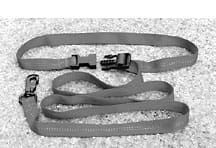With more than 25 years of working with animals professionally under my belt, I don’t find many new product concepts that come as a total and pleasant surprise to me. What a delight, then, to test hands-free leashes for Whole Dog Journal and discover that the best of these products, which started making their appearance in the pet supply retail market in recent years, offer far more than just a convenient way to free up your hands while walking your dog on leash.
Few things irritate me more than having a dog constantly tugging on the leash. Thanks to my new doggie daycare center, I now find myself in the position of walking untrained dogs far more frequently than before. With some trepidation, I decided to test the hands-free leash products on my daycare dogs. The first candidate was a large, rambunctious Old English Sheepdog with poor leash manners. I buckled one of the hands-free gadgets around my waist and set out across the parking lot.
Warning: If you decide to use one of these products, the greatest danger is rampant ridicule. Be prepared to fend off guffaws and wisecracks. Just as I stepped out the daycare door with MacDuff attached to my body, my landlord stepped out of his office across the blacktop parking lot, and broke into uproarious laughter. I smiled boldly, waved, and continued on.

When MacDuff reached the end of the leash and began to pull, I stopped. It was surprisingly easy to let my hips and lower back absorb the mild impact. MacDuff, feeling no give in the leash at all, quickly backed off the end of the leash a foot or so. I started forward again. It took just a few repetitions of the stop-start routine for MacDuff to realize that if he wanted to get to the grass to relieve his bladder he had to stop pulling.
I was amazed. I had tried the same routine earlier that day with this 80-pound bulldozer on a traditional leash, with no improvement whatsoever in the pulling behavior. I can only surmise that despite my best efforts, when he pulled on the regular leash there was a certain amount of give in my arm. With the waist-belt it was much easier for me to effectively prevent him from moving forward at all, thereby preventing him from getting any reward for pulling. I found the hands-free leash just as effective with several other pullers, from Pete the black Lab-mix to Jeep, the Boston Terrier.
I was concerned initially that the concept of a waist-leash might be contraindicated for someone with back problems. Dog walkers with such a condition should consult with their physician before using this product. But one of my clients with a bad back and a big Rhodesian Ridgeback found the hands-free leash much kinder to her back. When Gator pulled on a traditional leash, it torqued her sideways. With the hands-free leash, she could brace squarely and absorb the shock evenly and comfortably across her hips.
The only remaining concern I have is the size and strength of the person relative to the size and strength of the dog. Anyone walking a dog on a hands-free leash must outweigh the dog by enough to act as a solid anchor when the dog pulls. Children or frail people would not be any more able to control a pulling or lunging dog with a hands-free leash than they would be with a regular leash; in fact, the hands-free model could very well put them at risk of being toppled over or even dragged by a very large or strong dog. And while some of the products are marketed as being a useful accoutrement for joggers, I personally would not want to be suddenly yanked by the waist by a lunging dog while running.
As daunting as this concern sounds, I do think that hands-free leashes have something to offer the average person and the average dog. One definite advantage is the freedom granted to those of us who train with a clicker and treats. No longer do you have to juggle the leash, clicker, and food rewards – you’ve got one hand for the treats and one for the clicker; the leash takes care of itself. Need to scoop a pile of poop? Again, no worries over trying to manage the leash while doing the plastic bag thing. Have a problem with the dog pulling the leash out of your hand and taking off down the street without you? Not anymore!
As always, WDJ looks for value in the products we review. Convinced that the hands-free leash concept had something to offer, we focused on the criteria of cost, quality of materials and construction, safety, comfort, and ease of use as we tested four different models to see how they fared.
Please note that in this discussion, our “Safety” criterion relates to the product’s ability to hold the dog securely, without exposing him to harm. Because (as we already discussed) all of these products pose some risk of tripping or dragging the handler if used inappropriately (such as with a strong, untrained dog and a small or weak handler), we regard them as equally safe for the handler. We did note which products include quick-release snaps; such snaps could protect a handler from being dragged by an out-of-control, strong dog. However, releasing the dog, obviously, would expose him to the many dangers of being loose.
Unique designs
Often, when we review specialty or “niche” products, we can find only minute differences in the products’ designs. But each of the hands-free dog-walking products we reviewed takes a very different approach.
For example, the High Sierra Walk-A-Belt is all about the dog walker’s comfort. This was the first hands-free product we tested, and the one that convinced us that hands-free was a wonderful concept.
The Walk-A-Belt’s comfortable design is unparalleled. As the name suggests, this product is simply a belt that a person can use for anchoring a leash – you have to provide the leash! The belt comes in two styles, felt- or fleece-lined, both made of top quality materials and more than two inches wide for maximum comfort. The belt rests on your hips rather than around your waist, to provide maximum safety and comfort. The nylon straps are strong and well-stitched, with sturdy metal and plastic fittings. Buckle the belt on, snap the handle of your dog’s regular leash into the carabiner provided for this purpose, and off you go! One model has a sturdy plastic buckle; another has a strong metal snap. You also have the option of ordering one with a quick-release snap.
If you are training a dog who pulls, the High Sierra Walk-A-Belt would be the most comfortable and secure for you to wear.
The J. M. Rogers Company’s Dog Jogger is a very serviceable hands-free belt and leash combination. It is exceptionally well constructed, with high-quality nylon webbing, sturdy plastic clasps on the belt portion, and a strong metal snap that attaches to the dog’s collar.
We prefer the extra wide webbing on the belt of this brand over the narrow straps of the Safe Pet and Buddy System brands that follow. Although the fabric is not our favorite kind of soft and smooth nylon, its width enables the belt to be worn resting comfortably on the hips rather than snug around the waist. While the lack of padding makes the Dog Jogger less comfortable that the White Pines belt, it also makes it cooler – a significant factor in summer heat and humidity.
We appreciate the detachable leash feature: The leash snaps easily on and off the belt and can be held in the hand as a regular leash when desired.
The Safe Pet Hands-Free Leash is the least-complicated product we examined. Made of high quality, strong, soft, and supple webbing and sturdy plastic fittings, this is simply a nylon leash that terminates in an easily adjustable loop that clips around your waist. Should you choose, the loop can be minimized to a hand-sized loop and function as a regular leash as well.
We liked this product, and its coolness around the waist, but, as with the Dog Jogger, we found the waist fit less comfortable than the hip-hugging White Pine model.
The Buddy System hands-free leash incorporates numerous innovative features not found in any of the other models we tested. One innovation is a quick-release collar attachment that makes it easy to release and reattach your dog quickly. The quick-release buckle at the end of the leash also enables you to snap the end back to the waist belt if you release your dog, so you don’t have to carry the leash as you walk or jog. Cool!
It’s also extremely adjustable. The leash can be shortened or lengthened (from 22-40 inches) while attached to the belt, and also can be used as a regular leash when released from the belt. The company also offers “Extra Buddy” ($16) an extra piece that enables you to attach a second dog to the waist belt, and “Extend-A-Buddy” ($6), a piece that increases the length of the leash by 18” to 36”. Plus, the Buddy System comes in a wide variety of sizes. Their “little dog” model (for dogs under 20 pounds) uses three-quarter-inch webbing and costs just $18. The larger dog models use one-inch webbing, and come in three human waist sizes, from 22-40, 27-50, and 33-60 inches.
However, in our opinion, the nylon material used is of a slightly lower quality than that used in the Safe Pet product, the stitching on the seams appeared a little minimal, and on the item we tested, the metal collar snap was extremely stiff and difficult to release. If the company were to improve the quality of materials used, we would give this product our top rating. However, a person who wants 20 different ways to secure his dog to his body would probably like this product best, even as it is now.
The BP Jogger takes a totally different approach to the hands-free concept. It’s a leash made of a 24-inch plastic coil that stretches to 72 inches, with a Velcro-fastened cuff that is secured around your upper arm.
We don’t like this product for this particular application. The company’s literature explains that as the plastic coil extends when the dog pulls, its tension increases, which encourages the dog to stop pulling. We thought it worked in the exact opposite way. Despite the increased tension, the ability to stretch, we think, rewards the dog for pulling – he gets to move toward whatever he wants to see or sniff.
We liked the idea of the coiling leash; the fact that it could keep you from having to constantly release and take up the slack when the dog moves around is an attractive concept. But, in practice, the stretchiness prevents the handler from effectively restraining the dog within the Jogger’s six-foot limit. If a dog were to dart ahead of you at a bad time, there wouldn’t be much you could do to stop him. It’s like grabbing a dropped phone receiver by the middle of the cord – because the cord stretches, the receiver hits the floor anyway. It would be great, though, if you were walking somewhere that was perfectly safe for a dog to range around a six-foot perimeter.
Then there is the matter of fastening this leash to your upper arm; we found it to be an uncomfortable way to carry a leash, and the discomfort increases when a dog pulls. If you are really excited about the coiling feature, consider the BP Walker made by the same company – not at all a hands-free product, but the same coiling leash with a nylon loop handle on the end.
Also With This Article
Click here to view “Off Leash Training: Building Reliability”
Click here to view “How To Train Your Dog for Off Leash Walks”






